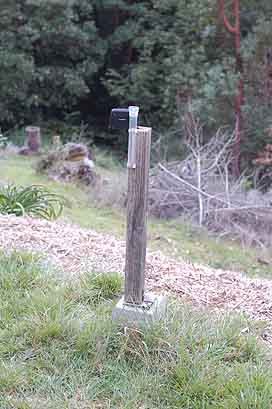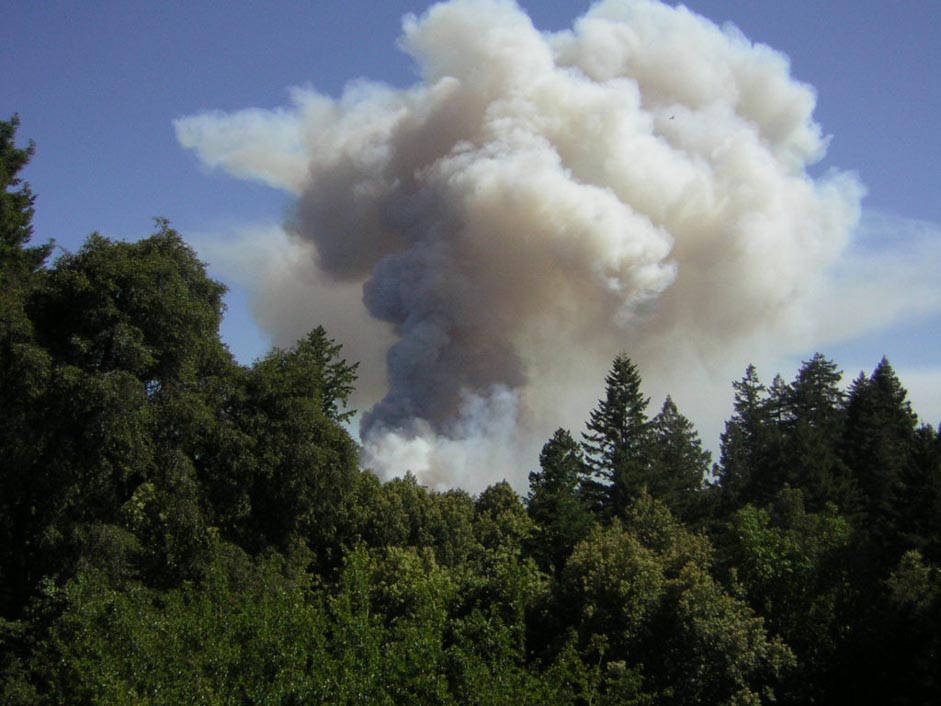Just for comparison, you can look at a table of rainfall totals for a few previous seasons:
1998/1999 season
Highlights of the Current Season - July 1, 2007 - June 30, 2008
By July 1st summer was already well
underway with very hot temperatures and clear skies. Temperatures
soared during the first week of July, with nights in the upper 80's and daytimes in
the 100 to 110 range. Somewhat cooler temperatures could be found in
town and at the beach below. Temperatures moderated during the second week, and continued through the next week. A rare rain event brought a little well-needed moisture on the 18th. Moderate temperatures and clear skies followed close after. The rest of the summer was fairly typical, a few hot spells moderated by normal warm temperatures. Late August was the hottest, and that lasted for a week or so.
September came in, and it was almost like mother nature decided to go along with the calendar this year, as temperatures cooled and it really felt like summer was over. Some light rain (mist, really) fell during the week of the 19th, enough to dampen the porch, and cloudy conditions increased by late in the week, bringing a chance of rain to the mountains for the first time since the rare rain event back in July. And on the 22nd, the first signiicant rain of the season came up from the south and stayed for a night and a day, reducing the fire danger significantly.
October began with a cool, cloudy 1st day, which gave way to sunny skies and warm daytime temperatures, and typical cool fall nights. The night of Oct. 9th brought the first winter storm to our mountain, with heavy rain and cold temperatures. The weather fronts continued through the week into the next, keeping things cool and wet. Indian summer arrived with a rush on October 23rd, with temperatures in the upper 80's. The first part of November brought more seasonal temperatures, and much needed rain on the 11th. But the rest of the month was mostly dry and pleasant. December came in with a little moisture and colder temperatures.And on the 7th, some much needed rain finally arrived. But even with the 2+ inches added in mid-December, it is still very dry. The end of December was quite cold and raw, with temperatures in the 30's and fairly damp.
January came in with a roar, bringing high winds and heavy rain, over 10 inches in three days. Power was knocked out, and many trees came down in the winds, which were in excess of 60 mph for at least 15 hours. Rain, along with lightning and thunder, continued through Sundy the 6th with very cool temperatures. Rainy and unsettled conditions lingered on after that. On the 21st, more moisture and light snow fell. And overnight on the 22nd, we had about 6 inches of snow on the ground, power outages, and trees down everywhere. More snow and cold rain fell on the 24th. The 25th brought a huge storm, not as cold, but very wet, and the biggest of the season (so far). Cool, wet and windy conditions continued into early February. A break in the winter weather rolled in around the 6th, and sunny skies with mild temperatures lingered until the 20th, when temps cooled off, and a little rain arrived on the 21st, with wet weather the norm for now. A dry spell was broken on March 15, with much cooler temperatures. It was dry until the 29th, when a brief but welcome shower passed by overnight. April was cool, and downright winter-like during the week of the 15th, with highs only in the mid-30's. Temperatures recovered and spring returned the next week. A brief shower passed by on the night of the 23rd.
Not another drop of rain since April, and Bonny Doon is dry, as is much of California. We hope for the best this year, as one fire anywhere here is too many.
Season total (to 8:00 AM, June 14, 2008): 48.41 Inches

The Rain Gauge
I keep these unofficial
readings as a personal interest. I have seen our reading exceed other
gauges that are located at lower elevations nearby, so I figured this
might be of interest to others. For rainfall amounts up to 5 inches, I
use a retail rain gauge. When amounts overnight are higher than 5
inches, I use, as a backup, a simple vertical wall bucket capable of
holding up to 14 inches. I have to use the bucket at least a few times
every winter. In years past, I was distrustful about the unusually high
rainfall readings, changing gauges and trying various methods and
locations to improve accuracy. However, after much experimentation, and
then checking with our neighbors, I think we are simply in a
micro-climate with more rain than other places. This is the Santa Cruz
Mountains, after all. As the Weather Service says, we are in an
"Orographically Favored Location." I think that means we get soggy when
others simply get wet.
During the 2005-2006
season, I added an electronic gauge. It sits next to the "analog"
gauge. So far, it tracks very close to the old fashioned method of
walking out in the rain and checking throughout the day and night. The
electronic gauge reads hundredths better than the old gauge, so it is
useful for that at least. I use both of them at the moment, and will
likely use them both for the foreseeable future. You never know when
the batteries might fail, after all.
There is one official
California Department of Water Resources weather monitoring site
located nearby, at a slightly higher elevation. They match my readings
here at 2200' fairly well. You can compare for yourself, at Ben Lomond Mountain
(2630', three miles up the road from here). Their measured rainfall
tends to be slightly less, but the temperature tracks pretty close to
our location.
There are also a couple of
other nearby, lower elevation locations where rainfall is measured. One
long-time measurement created by Ted Cantrall is here, and another very informative site, run by the folks at Anometal.com can be found here.
As with most places in this
region, we are in a "micro-climate". Ours happens to be very wet during
the rainy season, due to our location, elevation and southern exposure
to incoming storms. During large storms, average winds of 40 to 60 mph
are typical here. In December of 1995, we had winds approaching 100
mph, and during February, 1998, peak winds approached 85 mph. The
season is officially measured from July 1 to June 30, although rain
usually only falls between September and May, a typical "dry and wet"
seasonal pattern. Snow
does fall here, but it is usually not more than a few inches at a time.
The temperature range is not too extreme, and only falls below 25
degrees a few weeks every winter. 1991 was the exception, with lows in
the teens for over a week. The winters of 1973, 1975, 1982, 1986, 1995,
1998, 2001, 2002 and 2006 brought significant snowfall.
If you found your way to this page via a search engine, please refresh or reload the page for the latest updates.
You can return to the Home page here.



